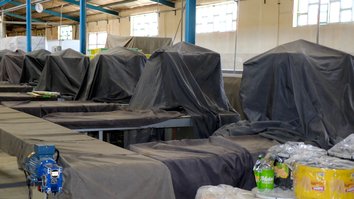Chinese authorities have demolished thousands of mosques in Xinjiang, an Australian think tank said Friday (September 25), in the latest report of widespread human rights abuses in the restive region.
More than one million Uighurs and other mostly Muslim Turkic-speaking people have been incarcerated in camps across the northwestern territory, with residents pressured to give up traditional and religious activities, say rights groups.
Chinese authorities destroyed or damaged about 16,000 mosques, according to an Australian Strategic Policy Institute (ASPI) report based on satellite imagery documenting hundreds of sacred sites and on statistical modelling.
Read the full ASPI report here.
![Before and after satellite images (2013 and 2018) of the Ordam Mazar desert outpost in Xinjiang. Chinese authorities have razed the entire site, built in the 10th and 11th centuries and held sacred to Muslims in the region. [ASPI]](/cnmi_pf/images/2020/09/25/26265-beforeandafter-585_329.jpg)
Before and after satellite images (2013 and 2018) of the Ordam Mazar desert outpost in Xinjiang. Chinese authorities have razed the entire site, built in the 10th and 11th centuries and held sacred to Muslims in the region. [ASPI]
Most of the destruction took place in the last three years and an estimated 8,500 mosques were destroyed, the report said, with more damage outside the urban centres of Urumqi and Kashgar.
Many mosques that escaped demolition had their domes and minarets removed, according to the research, which estimated fewer than 15,500 intact and damaged mosques were left standing around Xinjiang.
If correct, it would be the fewest Muslim houses of worship in the region since the decade of national upheaval sparked by the Cultural Revolution in the 1960s.
By contrast, none of the Christian churches and Buddhist temples in Xinjiang that the think tank studied had been damaged or destroyed.
Authorities razed almost a third of major Islamic sacred sites in Xinjiang -- including shrines, cemeteries and pilgrimage routes -- said ASPI.
An AFP investigation last year found dozens of cemeteries had been destroyed in the region, leaving human remains and bricks from broken tombs scattered across the land.
The September 25 report comes a day after ASPI said it had identified a network of detention centres in the region much larger than previous estimates.

![This photo taken on September 13, 2019, shows the remains of a Uighur cemetery in Kuche, Xinjiang, China, before workers turned it into a park. China is destroying burial grounds where generations of Uighur families have been laid to rest, leaving behind human bones and broken tombs in what activists call an effort to eradicate the ethnic group's identity in Xinjiang. [HECTOR RETAMAL/AFP]](/cnmi_pf/images/2020/09/25/26266-000_1ku8n9-585_329.jpg)






